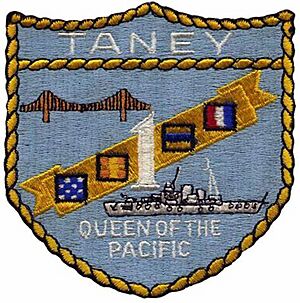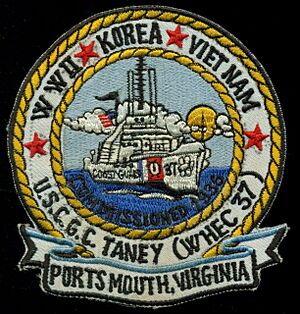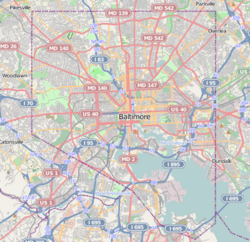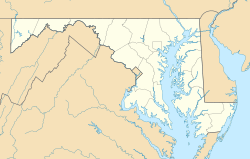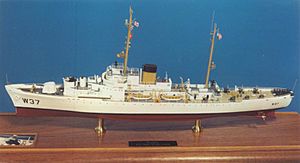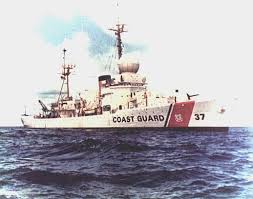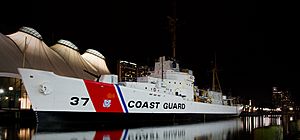USCGC Taney facts for kids
class="infobox " style="float: right; clear: right; width: 315px; border-spacing: 2px; text-align: left; font-size: 90%;"
| colspan="2" style="text-align: center; font-size: 90%; line-height: 1.5em;" | 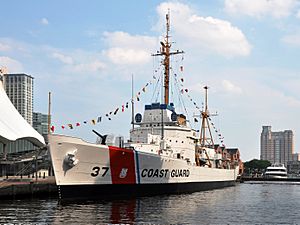
|} The USCGC Taney (WPG/WAGC/WHEC-37) is a famous ship from the United States Coast Guard. It was first named Roger B. Taney, after a historical figure named Roger B. Taney who was a U.S. Attorney General and Chief Justice. Later, its name was shortened to Taney.
This ship is special because it is the last warship still floating that fought in the attack on Pearl Harbor during World War II. It is also one of only two ships of its kind, called a Treasury-class cutter, that are still around.
The Taney was active for 50 years! It played important roles in both World War II and the Vietnam War. In World War II, it was a command ship at the Battle of Okinawa. It also helped protect other ships in the Atlantic and Mediterranean. During the Vietnam War, it took part in Operation Market Time. The Taney also helped protect fishing areas.
After being taken out of service in 1986, the Taney became a museum ship. You can visit it in Baltimore, Maryland. In 1988, it was named a National Historic Landmark. In 2020, the groups that care for the ship decided to call it simply WHEC-37. This was done because of Roger B. Taney's past actions related to racial injustice.
Contents
| History | |
|---|---|
| Name |
|
| Namesake | Roger B. Taney |
| Builder | Philadelphia Naval Shipyard |
| Laid down | 1 May 1935 |
| Launched | 3 June 1936 |
| Commissioned | 24 October 1936 |
| Decommissioned | 7 December 1986 |
| Identification | Call sign: NRDT |
| Motto |
|
| Status | Museum ship |
| Badge | |
| General characteristics | |
| Class and type | Treasury-class cutter |
| Displacement | 2,216 long tons (2,252 t; 2,482 short tons) |
| Length | 327 ft (99.67 m)o/a |
| Beam | 41 ft (12.50 m) |
| Draft | 12.5 ft (3.81 m) |
| Propulsion |
|
| Speed | 20.5 knots (38.0 km/h) |
| Range | 12,300 nautical miles (22,780 km) at 11 knots (20.4 km/h) |
| Capacity | 135,180 US gallons (511,712 L) |
| Complement |
|
| Sensors and processing systems |
|
| Armament |
|
| Aircraft carried | 1 Grumman JF-2 Duck |
|
USCGC TANEY (WHEC-37)
|
|
| Location | 1101 Key Hwy., Baltimore, Maryland |
| Built | 1936 |
| Architect | U.S. Coast Guard; Philadelphia Naval Shipyard |
| Architectural style | Treasury class cutter |
| NRHP reference No. | 88001826 |
| Significant dates | |
| Added to NRHP | 7 June 1988 |
| Designated NHL | 7 June 1988 |
- Post-War Service: 1946–1961
- New Missions: 1965–1966
- Vietnam War and Ocean Stations: 1968–1971
- Final Years of Service: 1972–1986
- Becoming a Museum Ship
- Awards and Honors
Early Years: 1936–1941
The ship, originally named Roger B. Taney, was built at the Philadelphia Naval Shipyard. Its construction began on May 1, 1935. It was launched into the water on June 3, 1936, and officially started service on October 24, 1936.
The Taney then traveled through the Panama Canal to its home port in Honolulu, Hawaii. This was in January 1937. In May or June 1937, its name was shortened to just Taney.
During this time, the United States was expanding air travel across the Pacific Ocean. Islands like Hawaii, Midway, Guam, and Wake Island became important stops for planes. The Taney helped with this by taking supplies and people to Kanton and Enderbury Island in March 1938. These people helped the U.S. claim these islands. The Coast Guard's job was to keep these island stations supplied.
As war approached, the Taney received more weapons. In December 1940, it was rearmed at the Pearl Harbor Navy Yard. In July 1941, the ship was transferred to the Navy to help with local defense around Honolulu. It often patrolled the harbor entrance, getting ready for what was to come.
World War II: A Ship at War
Attack on Pearl Harbor
On December 7, 1941, Japanese planes attacked Pearl Harbor. The message "Air Raid, Pearl Harbor. This is no drill" came at 7:55 AM. The Taney, docked in Honolulu harbor, quickly prepared for battle. Its anti-aircraft guns were ready in just four minutes.
The ship fired its new three-inch guns at Japanese planes flying overhead. It also fired on later groups of planes with its .50 caliber machine guns. The Japanese planes changed course to avoid the Taney's fire. Coast Guardsmen from the ship also helped protect the Aloha Tower on shore.
The Taney left the harbor on December 8 to patrol the waters. It detected possible submarines and dropped depth charges. For the rest of 1941 and into 1942, it continued to patrol around Honolulu. It often dropped depth charges on suspected submarines after the Pearl Harbor attack.
Pacific Operations
In January 1942, the Taney sailed to Kanton Island and Enderbury Island. It helped unload supplies and then evacuated American colonists from Enderbury Island. To prevent the buildings from being used by Japanese forces, the Taney shelled and destroyed them. It did the same at Jarvis Island.
After returning to Honolulu, the Taney made another trip to Palmyra Atoll. Later, after the Battle of Midway, it searched for survivors around Midway Island.
Atlantic Convoy Duty
In 1943, the Taney sailed to the East Coast of the U.S. It received new guns at Mare Island Naval Shipyard, getting four five-inch guns. This made it the only ship in its class with this setup.
In April 1944, the Taney joined a convoy (a group of ships traveling together) called UGS-38. While crossing the Atlantic, German planes attacked the convoy. They torpedoed several ships. One ship, the SS Paul Hamilton, exploded, killing all 504 people on board. Two torpedoes passed very close to the Taney.
The Taney completed two more convoy escort missions.
Command Ship at Okinawa
In October 1944, the Taney was changed into an amphibious command ship. This meant it could carry a high-ranking officer and their staff. It also got better communication and radar equipment. Its main guns were changed again to two five-inch guns, plus 40-millimeter and 20-millimeter anti-aircraft guns.
In March 1945, the Taney sailed to Okinawa. It arrived on April 11, during air raid alerts. Its gunners hit a Japanese "Betty" bomber. The ship went to general quarters (battle stations) 119 times in April and May. The crew sometimes stayed at their stations for nine hours!
During this time, the Taney shot down four suicide planes and helped destroy many others. It also managed radar and air coverage, tracking both friendly and enemy planes. Once, it even came under fire from a Japanese shore battery.
Japanese suicide attacks continued in June 1945. The Taney shot down a seaplane on June 25. In July and August, the ship had to lead convoys away from typhoons (tropical storms) to avoid damage.
The war ended with the Taney still off Okinawa. It later went to Japan to help with the occupation of Wakayama. The ship even survived a typhoon there, staying anchored while other ships struggled.
In October 1945, the Taney returned to the U.S. It was then changed back into a patrol cutter. It received a single five-inch gun, a hedgehog (an anti-submarine weapon), a twin 40-millimeter mount, and two 20-millimeter guns, plus depth charges.
Post-War Service: 1946–1961
After the war, the Taney was based in Alameda, California. Its main job was to be an "ocean station weather ship." This meant it would sail for three weeks at a time in assigned areas of the Pacific. Its main task was to collect weather information. This information was important for planes flying across the Pacific and for other ships.
The Taney also helped with communications and navigation. It was always ready for search and rescue missions. When not on weather duty, it performed law enforcement and search and rescue patrols.
In April 1960, the Taney had a special honor. It hosted Charles de Gaulle, the President of France, during his visit to San Francisco Bay.
New Missions: 1965–1966
In May 1965, the Taney was re-designated as a USCG high endurance cutter (WHEC-37). This meant it was a multi-mission ship that could operate at sea for a long time without needing support.
In March 1965, it helped put out a fire on a fishing vessel called Glacier Bear and then towed it to safety. In May 1965, it watched a Soviet ship closely off the coast of California.
In 1966, the Taney went on a long 90-day cruise. It traveled to Yokosuka, Japan, and spent time on "Ocean Station Victor." During this time, it survived Typhoon Marie, with winds of almost 70 knots (130 km/h), without damage.
Vietnam War and Ocean Stations: 1968–1971
After more ocean station duties, the Taney was sent to support the Navy's Operation Market Time off the coast of Vietnam. It served there for 10 months, from May 1969 to January 1970.
During its time in Vietnam, the Taney traveled over 52,000 miles. It inspected more than 1,000 vessels. It also fired over 3,400 five-inch shells at enemy positions to support ground troops. The ship's medical staff treated over 6,000 Vietnamese villagers. For its service, the Taney received the Vietnam Gallantry Cross and the Vietnam Civil Actions Medal.
After returning from Vietnam, the Taney went back to its ocean station duties in the Pacific until 1971.
Final Years of Service: 1972–1986
In February 1972, the Taney moved to the East Coast, based in Norfolk. As technology improved, ocean stations became less needed. By the mid-1970s, the Taney was assigned only to "Ocean Station Hotel." This station was off the coasts of Maryland and Virginia.
The Taney was fitted with a special dome-shaped antenna on its pilot house. This antenna helped it track storms threatening the East Coast. The ship would deploy seven times a year for these missions. Eventually, satellites and better radars made this station unnecessary. The Taney had the honor of being the last Coast Guard cutter to serve on an ocean station when it closed in 1977.
In the mid-1970s, the Coast Guard focused more on protecting fisheries and stopping smugglers. From 1976 until it was decommissioned, the Taney was based in Portsmouth, Virginia. It performed law enforcement and search and rescue patrols.
In January 1980, the Taney had a very busy month. It helped search for a lost jet and seized a ship carrying 4 tons of illegal goods. In December 1980, it seized another ship with 10 tons of illegal items. The Taney also continued its humanitarian work. In November 1982, it rescued seven people from a disabled boat and 19 migrants from another sailboat.
Becoming a Museum Ship
The Taney was officially taken out of service on December 7, 1986. It was then given to the city of Baltimore, Maryland, to become a museum ship.
Throughout its long and important career, the Taney earned three battle stars for its service in World War II. It also received many awards for its work in World War II, the Korean War, and the Vietnam War.
In 1988, the USCGC Taney (WHEC-37) was added to the National Register of Historic Places. It was also named a National Historic Landmark on the same day. Today, the Taney is located in Baltimore's historic Inner Harbor. It is part of the Historic Ships in Baltimore collection, where people can visit and learn about its history.
Awards and Honors
- Coast Guard Meritorious Unit Commendation
- Navy Meritorious Unit Commendation
- American Defense Service Medal
- American Campaign Medal
- European-African-Middle Eastern Campaign Medal with one battle star
- Asiatic-Pacific Campaign Medal with two battle stars
- World War II Victory Medal
- Navy Occupation Service Medal with "ASIA" clasp
- National Defense Service Medal with one service star
- Korean Service Medal
- Vietnam Service Medal with three campaign stars
- Humanitarian Service Medal
- Vietnam Gallantry Cross with palm
- Vietnam Civil Actions Medal with palm
- United Nations Korea Medal
- Republic of Vietnam Campaign Medal


